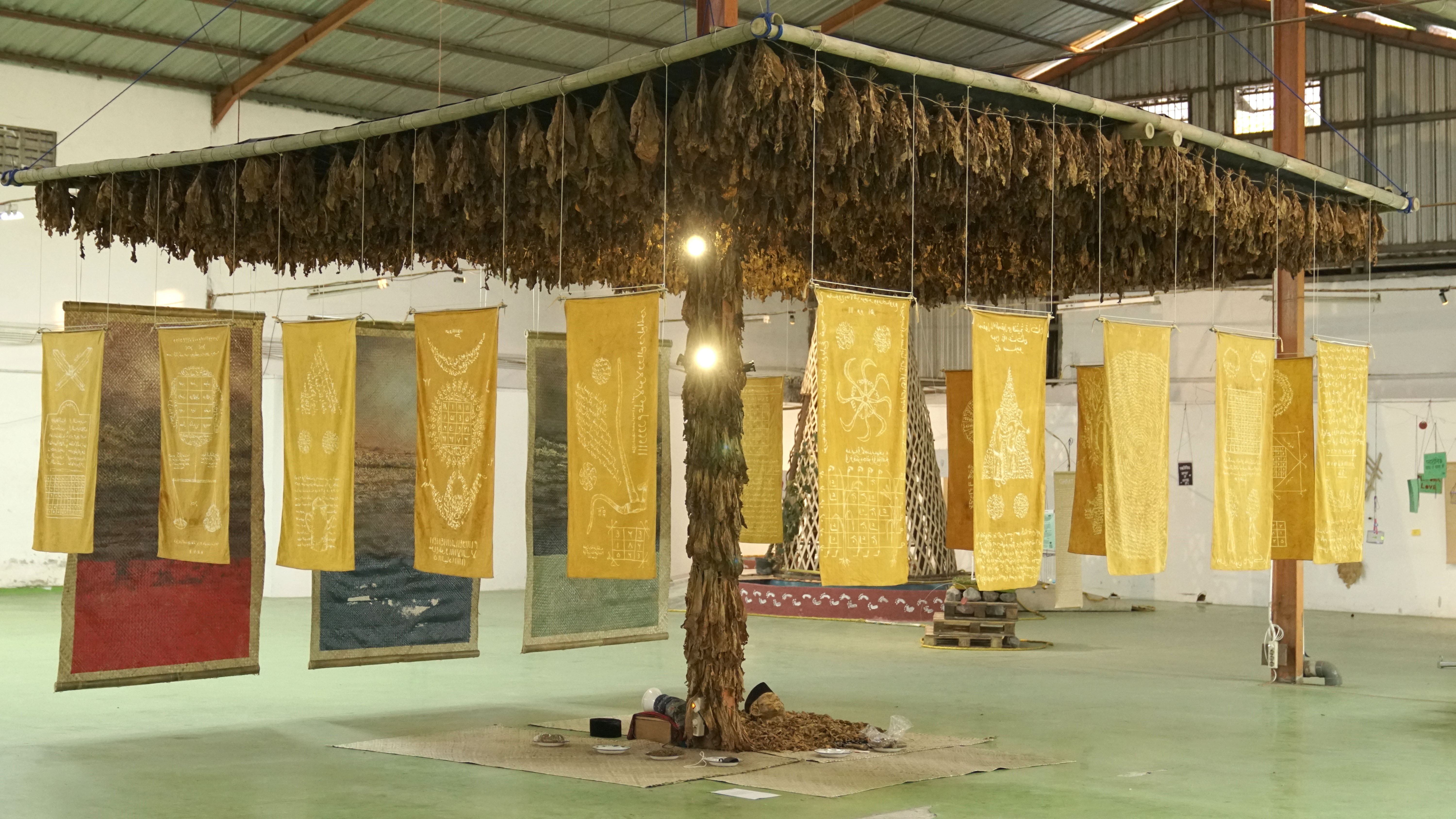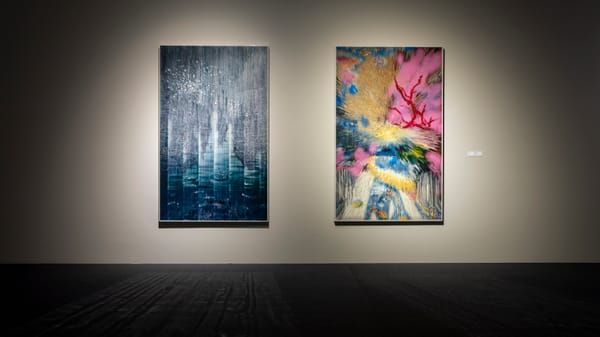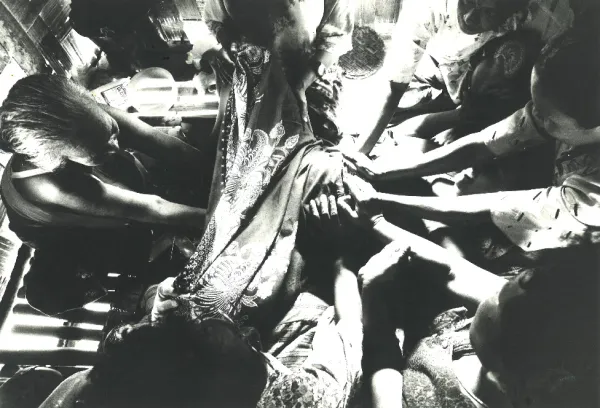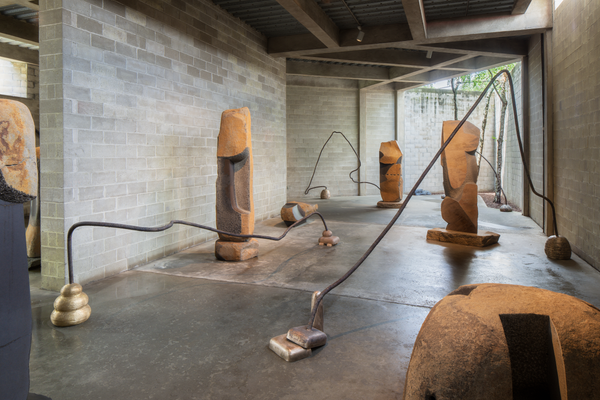Shows
Jogja Biennale 17: Translocality and Transhistoricity
%201.jpg)
%201.jpg)
Jogja Biennale 17
Various locations, Yogyakarta, Indonesia
Oct 6–Nov 25
Yogyakarta (or Jogja) has long stood as a beacon for collective art practice in Indonesia, with the Jogja Biennale upholding a collaborative and transnational ethos through its broad selection of artists and its diverse public program. For its 17th edition—“Titen: Embodied Knowledge, Shifting Grounds”—director Alia Swastika, alongside curators Eka Putra Nggalu, Sheelasha Rajbhandari, Hit Man Gurung, and Adelina Luft, zeroed in on the theme of decolonizing knowledge production by exploring notions of locality. This year, 70 local and international artists were invited to examine and respond to the extant wisdom and resistance within small communities of various trades in and around Yogyakarta.
One approach was to unpack the politics of soil-based practices and ecological histories. Located at the Gudang Bibis warehouse, a large-scale installation by the Madurese Lembâna Artgroecosystem collective titled Bhâko: So Which of the Favors of Your Land Would You Deny? (2023) referenced a verse from “Surah Ar-Rahman” (a chapter from the Qur’an) to invoke an inquisitive gratitude toward the land, specifically, Madura Island. An expansive square canopy was erected and covered in dried tobacco leaves, a subsistence crop that fuels the kretek (clove cigarette) industry, a mainstay of the island’s economy since the Dutch era. Suspended from its edges were tie-dyed textiles adorned with Pegon (a modified Arabic script used to write Javanese and Madurese languages) detailing droughts, rain prayers, and spells. Beneath the canopy, viewers were submerged in narratives of nicotine-scented violence (colonial control and enforced labor) and resistance (through incantations and linguistic camouflage) as a way to better understand the complex histories embedded in the Madurese soil.

Meanwhile, Jogja-based Jompet Kuswidananto chose to immerse himself in the poetics of mythology by recalling a childhood ghost story in which a spectral marching band of soldier spirits would float down the road on moonless nights. This oral myth, which continues to haunt Kuswidananto's imagination, materialized as Anno Domini (2011), an installation located inside the infamous Bibis Monument. Consisting of six ghostly figures wearing white plastic vests, turbans, and combat boots—a nod toward the uniform of the Javanese Royal Army created after the Java War (1825–30), when the Dutch took control—each poltergeist is attached to a musical instrument, churning out a bell chime or a drum beat. To Kuswidananto, the war and its horrors continue with the Dutch modernization campaigns that ravaged Java, captured here through the industrial clanking noises and the soldiers’ uniforms, a combination of local and Western garments. By situating these figures on a haunted stage inside a monument dedicated to President Suharto and his brutal Orde Baru (New Order) regime, Kuswidananto’s sought to link various stages of conflict by weaving together aural and theatrical components.
.jpg)
From the remnants of past trauma embedded in the soil to the exorcising of restless spirits, a third approach was to investigate the sacredness of sites as a way of connecting disparate localities. Collaborating with the Jogja-based Matrahita collective, Kalimpong-based artist Alyen Foning summoned Eikam-Interconnected (2023), a globe comprised of upcycled textiles that marries the divine Mount Kanchenjunga of her Lepcha community in the Eastern Himalayas and Mount Merapi in Java, Indonesia—sites that figure in the origin myths of their respective spaces. Within this web-like Earth, woven from lace threads, stood a textile-based monument to the Tree of Life that interweaves sacred beings such as the Oong Sader Water Dragon (a symbol of the Lepcha’s rivers) and the Api Naga Raja (a Javanese mythical creature that prevents the Earth from collapsing). Underneath the globe, Foning placed a seed from a plant found in both Kalimpong and Java, signifying the trans-local link that connects the two regions through the shared reverence for their sacred ancestral homes.
Notably, this was the first time that the Biennale showed work across various locations (previous iterations were predominantly held at the Jogja National Museum), which in turn allowed local communities to highlight their own agricultural products and festive rituals. Certainly a laudable attempt to initiate dialogue between the organizers, artists, and local residents, but the manner and depth with which these collaborations occurred was also subject to critical examination and reflection. One hopes that “Titen” serves as a catalyst for the Biennale’s continued effort to forge meaningful conversations between myriad interests and perspectives.
Hung Duong is a Ho Chi Minh City-based writer and curator.







